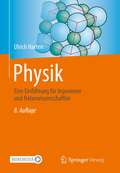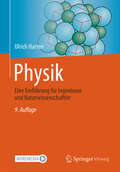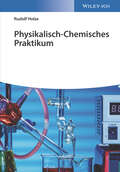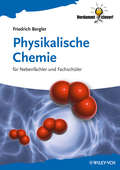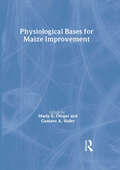- Table View
- List View
Physik unserer Umwelt: Die Atmosphäre
by Thomas Wagner Walter RoedelDas Buch basiert auf einer zweisemestrigen Vorlesung an der Universität Heidelberg über die Physik der Atmosphäre. Der Autor erklärt einerseits das System Atmosphäre und vermittelt andererseits umweltrelevante Aspekte. Die Neuauflage wurde zum Teil grundlegend überarbeitet. So wurden für die Kapitel zu Spurenstoffen und zur Klimamodellierung die neuesten Forschungserkenntnisse eingearbeitet, das Kapitel über Aerosole um Abschnitte zu deren chemischer Bedeutung ergänzt. Mit umfangreichem Register sowie ausführlichen Quellen- und Literaturangaben.
Physik unserer Umwelt: Die Atmosphäre
by Thomas Wagner Walter RoedelDas vorliegende Lehrbuch bietet eine Einführung in die Physik der Atmosphäre, wie sie im Rahmen der Umweltphysik gelehrt wird. Zuerst wird dem Leser die Funktionsweise des Systems Atmosphäre verständlich gemacht. Dazu werden Themen wie Strahlungs- und Energiehaushalt, atmosphärische Dynamik, Zirkulationen, Niederschlagsbildung und der Wasserkreislauf behandelt. Zudem werden die umweltrelevanten Aspekte der Meteorologie und der Atmosphärenphysik herausgearbeitet. Hierzu dienen unter anderem eine ausführliche Darstellung von Diffusions- und Transportprozessen sowie zahlreiche Abschnitte über das Verhalten von Spurenstoffen, mit Schwerpunkt auf strahlungsrelevanten Spurengasen und Aerosolen. Eine Diskussion von Klima-Entwicklungen und deren Bewertung rundet den Inhalt ab und bietet damit einen umfassenden Überblick über das Thema. Änderungen gegenüber der 5. Auflage betreffen insbesondere die letzten 3 Kapitel. Einerseits wurde in den letzten 6 Jahren eine Vielzahl neuer Forschungsergebnisse verfügbar. Andererseits hat sich in diesem Zeitraum auch der Zustand unseres Planeten weiter dramatisch verändert. In der neuen Auflage werden hierzu die neuesten verfügbaren Messdaten und Studien berücksichtigt. Das Buch wendet sich ebenso an Studierende der Physik und der Geowissenschaften wie an Wissenschaftler(innen) und Lehrer(innen), die sich für ihre berufliche Arbeit eine Einführung in die atmosphärische Physik und in die Umweltmeteorologie wünschen. Ein umfangreiches Register ermöglicht das schnelle Auffinden eines Themas, die große Zahl von Quellen- und Literaturangaben erleichtert den Zugang zu weiteren Informationen.
Physik: Eine Einführung für Ingenieure und Naturwissenschaftler
by Ulrich HartenDie Grundlagen der Physik - kurzweilig, anschaulich und präzise.Über 400 Abbildungen und zahlreiche Beispiele aus dem Alltag fördern das Verständnis für physikalische Zusammenhänge. Die im Dialog mit Studenten erarbeitete Didaktik wird durch das ansprechende zweifarbige Layout unterstützt und erleichtert das Lernen. Über 300 Verständnisfragen und Übungsaufgaben mit Antworten im Anhang regen zu selbständiger Beschäftigung mit der Thematik an. Das Werk ist nicht nur für die Prüfungsvorbereitung hervorragend geeignet. Aufgrund des ausführlichen Sachverzeichnisses ist es auch als Nachschlagewerk zu empfehlen.Auf seiner Internetseite bietet der Autor interessante Links, Animationen und ergänzend zu den einzelnen Buchkapiteln Verständnisfragen mit kommentierten Lösungen zum Download an.In der 8. Auflage wurde das Buch aktualisiert und überarbeitet. Zudem wurden zahlreiche Videos in das Buch eingebracht.„Ein trockenes Fach"...ist das Urteil der meisten Studenten über die Physik. Mit umso mehr Vergnügen werden Sie dieses Lehrbuch zur Hand nehmen.
Physik: Eine Einführung für Ingenieure und Naturwissenschaftler
by Ulrich HartenDie Grundlagen der Physik - kurzweilig, anschaulich und präzise.Über 400 Abbildungen und zahlreiche Beispiele aus dem Alltag fördern das Verständnis für physikalische Zusammenhänge. Die im Dialog mit Studenten erarbeitete Didaktik wird durch das ansprechende zweifarbige Layout unterstützt und erleichtert das Lernen. Über 300 Verständnisfragen und Übungsaufgaben mit Antworten im Anhang regen zu selbständiger Beschäftigung mit der Thematik an. Das Werk ist nicht nur für die Prüfungsvorbereitung hervorragend geeignet. Aufgrund des ausführlichen Sachverzeichnisses ist es auch als Nachschlagewerk zu empfehlen.Auf seiner Internetseite bietet der Autor interessante Links, Animationen und ergänzend zu den einzelnen Buchkapiteln Verständnisfragen mit kommentierten Lösungen zum Download an.In der 9. Auflage wurde das Buch aktualisiert und überarbeitet. Zudem wurden zahlreiche Videos in das Buch eingebracht.„Ein trockenes Fach"...ist das Urteil der meisten Studenten über die Physik. Mit umso mehr Vergnügen werden Sie dieses Lehrbuch zur Hand nehmen.
Physik: Eine Einführung für Ingenieure und Naturwissenschaftler (Springer-Lehrbuch)
by Ulrich HartenMit Auftrieb durch die Physik In der Physik geht es wahrlich um mehr als nur hei#65533;e Luft. Mechanik, Optik, Elektrizit#65533;tslehre und Co. erschlie#65533;en sich nur wenigen Medizinstudenten intuitiv. Da kommt der Harten mit seiner verst#65533;ndlichen Sprache und den vielen Beispielen aus Alltag und Klink gerade recht, um f#65533;r Auftrieb zu sorgen. Kennt man die physikalischen Grundlagen, ist vieles in der Physiologie und sp#65533;ter in der klinischen Therapie und Diagnostik viel leichter zu verstehen - man denke nur an die Infusion oder ans R#65533;ntgen. Und f#65533;rs Verstehen hat ,,Physik f#65533;r Mediziner" jede Menge zu bieten: #65533; Physik in einfacher Sprache und mit vielen Beispielen aus Alltag und Klinik #65533; Hervorhebung der h#65533;ufigsten Pr#65533;fungsthemen #65533; Formelsammlungen, Verst#65533;ndnisfragen und #65533;bungsaufgaben am Kapitelende #65533; Spezielle Boxen f#65533;r die Vorbereitung auf das Praktikum - Zusatzmaterial auf der Autorenhomepage Die 14. Auflage wurde komplett bearbeitet, alle Themen aus dem GK sind enthalten und mehr als 430 farbige Abbildungen sorgen f#65533;r Aha-Effekte. Harten - Physik kann ganz leicht sein
Physik: für Studierende der Naturwissenschaften und Technik
by Paul A. Tipler Gene MoscaDer Tipler bietet die gesamte Physik, wie sie in den ersten Semestern im Rahmen eines Bachelorstudiums in den Natur- und Ingenieurwissenschaften gelehrt wird. Die ausführlichen und leicht nachvollziehbaren Erklärungen sowie zahlreiche Rechenbeispiele, Tipps und Methoden machen dieses Buch zu einem beliebten Begleiter im Studium. Weitere Aufgabenstellungen zur Übung am Ende jedes Kapitels in verschiedensten Schwierigkeitsgraden sowie ein Crashkurs zum Nachschlagen der benötigten mathematischen Grundlagen helfen beim Ver- und Bestehen von Vorlesungen, Übungen und Klausuren. In der neuen Auflage werden Übungsbeispiele mit einer schrittweisen, anwendungsbezogenen Einführung in das Programm MATLAB® angeboten, welches in vielen natur- und ingenieurwissenschaftlichen Fächern als Werkzeug verwendet wird.Der Tipler ist insbesondere auch für diejenigen Leserinnen und Leser geeignet, die in der Schule Physik nur als Grundkurs hatten oder sogar so früh wie möglich abgewählt haben – und nun rasch Grundlagen und physikalische Zusammenhänge aufholen müssen.Ob Physik im Haupt- oder Nebenfach - der Tipler bietet Ihnen alles in einem Buch:verständliche, nachvollziehbare Darstellung des physikalischen Inhaltsüber 480 Schritt-für-Schritt gerechnete Beispiel- und Übungsaufgabennützliche Tipps und Tricks um typische Fehler zu vermeidenZusammenfassungen mit den wichtigsten Gesetzen und Formelnanschauliche und übersichtliche Grafikendurchgehend farbiges und farbkodiertes Layout Kurzbeiträge von Forschern, die aktuelle Themen im Kontext illustrieren.Der InhaltMechanik - Schwingungen und Welle - Thermodynamik - Elektrizität und Magnetismus - Optik - Relativitätstheorie - Quantenmechanik - Atom- und Molekülphysik - Festkörperphysik - Kern- und Teilchenphysik
Physikalisch-Chemisches Praktikum
by Rudolf HolzePhysikalisch-Chemisches Praktikum Erfolgreich durchs Praktikum der Physikalischen Chemie! Das Buch bietet eine umfassende Sammlung nach einheitlichem Schema aufgebauter Versuchsbeschreibungen, die alle Teilgebiete der Physikalischen Chemie abdeckt – entsprechend der von der Deutschen Bunsen-Gesellschaft für Physikalische Chemie verabschiedeten und publizierten Mindestinhalte der Lehre in diesem Fach. In jedem der den klassischen Hauptarbeitsgebieten der Physikalischen Chemie gewidmeten Hauptkapitel finden sich zunächst einfache Versuche, die mit wenigen Mitteln bereits beim Verständnis wichtiger grundlegender Tatsachen helfen. Der Schwierigkeitsgrad und oft auch der apparativ-experimentelle Aufwand steigen dann, bis gegen Ende der Kapitel der typische Inhalt von Fortgeschrittenen-Praktika vorgestellt wird. Damit schlägt das vorliegende Buch die Brücke zwischen dem Grundlagenwissen aus Vorlesungen und Lehrbüchern und der Bedienungsanleitung eines Messgerätes oder den praktischen Vorgaben der Versuchsbetreuerinnen und -betreuer. Es ersetzt dabei weder das Lehrbuch noch die Bedienungsanleitung, es erklärt vielmehr, wie sich der experimentelle Aufbau und das praktische Vorgehen nachvollziehbar aus dem Lehrbuch- und Vorlesungswissen ergeben.
Physikalische Chemie
by Peter W. Atkins Julio de Paula James J. KeelerDas unverzichtbare, umfassende Lehrbuch der Physikalischen Chemie! Der "große Atkins" ist und bleibt ein Muss für alle Studierenden, die sich ernsthaft mit der Physikalischen Chemie auseinandersetzen. In unverwechselbarem Stil deckt Peter Atkins mit seinen Koautoren Julio de Paula und James Keeler die gesamte Bandbreite dieses faszinierenden und herausfordernden Fachs ab. In der neuen, sechsten Auflage ist der Inhalt modular aufbereitet, um so das Lernen noch strukturierter und zielgerichteter gestalten zu können. Wie immer beim "Atkins" gehen Anschaulichkeit und mathematische Durchdringung des Stoffes Hand in Hand. Und natürlich kommt der Bezug zu den Anwendungen der Physikalischen Chemie und ihrer Bedeutung für andere Fachgebiete nie zu kurz. * Jeder Abschnitt stellt explizit Motivation, Schlüsselideen und Voraussetzungen heraus * Durchgerechnete Beispiele, Selbsttests und Zusammenfassungen der Schlüsselkonzepte erleichtern Lernen und Wiederholen * Kästen mit Hinweisen zur korrekten Verwendung von Fachsprache und chemischer Konzepte helfen dabei, typische Fehler und Fehlvorstellungen zu vermeiden * Herleitungen von Gleichungen erfolgen in separaten Toolkits, um das Nachschlagen und Nachvollziehen zu erleichtern * Diskussionsfragen, leichte Aufgaben, schwerere Aufgaben, und abschnittsübergreifende Aufgaben in umfangreichen Übungsteilen an den Abschnittsenden * Das Arbeitsbuch ist separat erhältlich und mit dem Lehrbuch im Set Zusatzmaterial für Dozentinnen und Dozenten erhältlich unter www.wiley-vch.de/textbooks
Physikalische Chemie I: Thermodynamik und Kinetik
by Marcus ElstnerDieses Lehrbuch ist essentiell f#65533;r Studierende im Bachelor-Studiengang Chemie. Es geht um "wissen", "verstehen" und "anwenden". Das Wissen um die grundlegenden Gesetze und Ph#65533;nomene. Das Verstehen der Konzepte und Grundlagen. Das Anwenden der Thermodynamik, Kinetik und Elektrochemie auf chemische Fragestellungen.
Physikalische Chemie II: Quantenmechanik und Spektroskopie
by Marcus ElstnerDieses Lehrbuch führt in die Grundlagen der Quantenmechanik und Spektroskopie für Chemiker im Bachelor-Studium ein. Es wird dabei besonderes Augenmerk auf Verständlichkeit, gute Lesbarkeit und übersichtliche Darstellung gelegt. Im Mittelpunkt steht die Anwendung der Quantenmechanik auf die Struktur und die elektronischen Eigenschaften von Molekülen sowie deren experimentelle Aufklärung.Dieses Buch soll einen leichten Zugang für Einsteiger ermöglichen, ist jedoch durch seinen modularen Aufbau auch als Vertiefung für Fortgeschrittene geeignet. Mathematische Grundlagen wie die Schrödinger-Gleichung, Wellenfunktionen und Operatoren werden auf einfache Weise vorgestellt und durch historische Bezüge verständlich gemacht. In den Teilen zur Anwendung der Quantenmechanik wird gezeigt, wie aus den physikalischen Modellen der Quantenmechanik die zentralen Konzepte der Chemie entstehen und wie diese zur Beschreibung der elektronischen Struktur von Atomen und Molekülen sowie ihrer spektroskopischen Eigenschaften verwendet werden. Durch die Anwendung der Quantenmechanik auf konkrete, chemische Fragestellungen wird dies eingängig erläutert und eine Diskussion der Interpretationsfragen soll das Verständnis der Quantenmechanik vertiefen.
Physikalische Chemie für Dummies (Für Dummies)
by Georg HeunSo stimmt die Chemie mit der Physik Wie die Organische und die Anorganische Chemie ist die Physikalische Chemie eines der klassischen Teilgebiete der Chemie. Sie beschäftigt sich mit dem Grenzbereich von Chemie und Physik. Georg Heun erklärt Ihnen, was Sie über Kräfte und Elemente, Reinstoffe, Mischungen, Wechselwirkungen, Elektrochemie und Thermodynamik wissen sollten. Mit vielen Übungen erläutert er so verständlich wie möglich die Grundlagen und hilft Ihnen bei Ihren ersten Schritten auf dem Gebiet der Grenzbereich der Physikalischen Chemie. Sie erfahren Wie wichtig Viskosität ist Welche Grenzflächenphänomene auftreten können Was Sie unbedingt über Reaktionskinetik wissen sollten Was die Bausteine der Thermodynamik sind
Physikalische Chemie für Dummies (Für Dummies)
by Georg HeunWie die Organische und die Anorganische Chemie ist die Physikalische Chemie eines der klassischen Teilgebiete der Chemie. Wie ihr Name schon sagt, beschäftigt sie sich mit dem Grenzbereich von Chemie und Physik. Georg Heun erklärt Ihnen, was Sie über Kräfte und Elemente, Reinstoffe, Mischungen, Wechselwirkungen und Thermodynamik wissen sollten. Mit vielen Übungen erläutert er so verständlich wie möglich die Grundlagen der Physikalischen Chemie und hilft Ihnen so bei Ihren ersten Schritten in diesem Grenzbereich der Naturwissenschaften.
Physikalische Chemie kompakt
by Jakob „SciFox“ LauthFür das Verständnis vieler technischer, chemischer und biologischer Prozesse ist ein solides Basiswissen der Thermodynamik und Kinetik notwendig. Das vorliegende Buch basiert auf einem multimedialen Kurs für Bio- und Chemie-Ingenieure, welcher die Neugierde und Eigeninitiative der Studenten triggern soll. Die einsemestrige Grundlagenvorlesung wurde in 12 Workshops (Kapitel) unterteilt. Jedes Kapitel behandelt einen praxisrelevanten Bereich der Physikalischen Chemie und enthält die folgenden didaktischen Elemente, die dieses Buch besonders spannend und verständlich machen: - Videos zu jedem Kapitelstart als Vorbereitung zum Workshop - Schlüsselbegriffe (fettgedruckt) für weitere eigene Recherche - Verständnisfragen und Rechenübungen mit Lösung als Lernkontrolle - Schlüsselabbildungen als einfache, leicht nachzuzeichnende Tafelbilder Humorvolle Cartoons zu jedem Workshop (by Faelis) lockern den Text zusätzlich auf und erleichtern als Eselsbrücke den Lernprozess. Als Abrundung des Kurses finden sich im Anhang eine Zusammenfassung der bekanntesten Experimente im physikalisch-chemischen Grundpraktikum sowie Vorschläge für die Gestaltung der Workshops mit Exponaten, Experimenten und "Fragen des Tages". Geeignet ist dieses Buch für Studenten mit Nebenfach Chemie, wobei auch Chemiestudenten dieses verschlankte, didaktisch wertvolle Werk sicher hilfreich finden. Das Buch ist hervorragend zum Selbststudium geeignet.
Physikalische Chemie: Für Natur- Und Ingenieurwissenschaftliche Studiengänge (Wiley-VCH-Lehrbuchkollektion 1)
by Peter W. Atkins Julio de PaulaDer "große Atkins" ist und bleibt ein Muss für jeden Studierenden, der mit physikalischer Chemie zu tun hat. Wie immer didaktisch brillant präsentieren Peter Atkins und Julio de Paula die gesamte Bandbreite dieses faszinierenden Fachs. Für die neue Auflage wurde der Inhalt noch einmal komplett überarbeitet und dabei stärker auf die Anwendungen der physikalischen Chemie und ihre Bedeutung für andere Fachgebiete ausgerichtet. Was ist neu? Ein einführendes Kapitel zu den Grundlagen fasst wichtige chemische und physikalische Schlüsselprinzipien zusammen. Ein abschließendes Kapitel über Katalyse trägt der gestiegenen Bedeutung dieses Themas für alle chemischen Prozesse Rechnung. Aspekte der Modellierung und der Computerchemie sowie der Materialwissenschaft sind jetzt verstärkt in das Buch integriert. Zusatzinformationen und Mathematische Exkurse mit den Herleitungen wichtiger Gleichungen vertiefen das Gelernte. Die Zusammenfassung der Lernziele am Anfang eines Kapitels (Das Wichtigste in Kürze) und der wichtigsten Gleichungen am Kapitelende (Die wichtigsten Gleichungen auf einen Blick) erleichtern das Wiederholen der Lerninhalte. Der Tabellenanhang mit vielen nützlichen Stoffdaten wurde konsolidiert und ist nun wesentlich übersichtlicher. Was wurde beibehalten? Alle Grafiken sind in Farbe und in einem einheitlichen Stil gestaltet. Rechenbeispiele mit kommentiertem Lösungsweg und dazugehörigen Übungsaufgaben zeigen wie es geht. Diskussionsfragen, Leichte und Schwere Aufgaben zur jedem der Kapitel ermöglichen eine Verständniskontrolle und erleichtern das Einüben des Gelernten. Eine elektronische Version des Buches mit online-Zusatzmaterial ist auf der e-Learning-Plattform WileyPlus erhältlich. Begleitmaterial für Dozenten verfügbar unter www.wiley-vch.de/textbooks
Physikalische Chemie: für Nebenfächler und Fachschüler (Verdammt clever!)
by Friedrich BerglerKompakt und »verdammt clever« auf den Punkt gebracht - In einfachen Worten und unter Rückgriff auf Alltagsphänomene werden die Grundlagen der Physikalischen Chemie erarbeitet. Zahlreiche einprägsame Abbildungen, Merksätze, Begriffsdefinitionen und Erläuterungen ermöglichen einen leicht verständlichen Zugang zu grundlegenden Themen der Physikalischen Chemie. Alle wichtigen Gleichungen werden in ihrer Bedeutung erklärt und anhand von Rechenbeispielen eingeübt. Der Stoffumfang ist für alle naturwissenschaftlichen und technischen Fächer geeignet, die Physikalische Chemie als Nebenfach oder als Teil einer Ausbildung in allgemeiner Chemie vorsehen. Aufgrund des Praxisbezugs ist das Werk auch für die Verwendung in beruflichen Schulen bestens geeignet. Mit dem Blick aufs Wesentliche gerichtet, werden die Grundlagen der physikalischen Chemie in kompakter und leicht nachvollziehbarer Form vermittelt. Dabei unterstützen besondere Textelemente Ihren Lernerfolg: * Für die inhaltliche Orientierung sorgen optisch hervorgehobene Schlüsselthemen am Kapitelanfang. * Das Wichtigste wird kurz und prägnant in Definitionen und Merksätzen zusammengefasst. * Beispiele helfen beim Anwenden des Lernstoffs. * Die Formelsammlung am Ende eines jeden Kapitels verschafft einen schnellen Überblick über die wichtigsten Zusammenhänge. * Zu jedem Thema gibt es Verständnisfragen und Aufgaben mit Lösungen, die beim eigenständigen Überprüfen des Gelernten helfen.
Physikalische Chemie: für natur- und ingenieurwissenschaftliche Studiengänge. Arbeitsbuch
by David SmithDer "kleine" Atkins ist ideal für Bachelor-Studierende der Chemie und Studierende anderer Naturwissenschaften sowie der Ingenieurwissenschaften: das Buch führt ein in die Grundlagen der Physikalischen Chemie, die besonders hohe Anforderungen an die Studentinnen und Studenten stellt. Das erstmals auf Deutsch vorliegende Arbeitsbuch zur 5. Auflage des "kleinen" Atkins ermöglicht die eigenständige Kontrolle des Lernerfolgs dank der ausführlich durchgerechneten Lösungen der mehr als 800 Aufgaben aus dem Lehrbuch. Auch im attraktiven Deluxe-Set mit dem Lehrbuch erhältlich!
Physikalische Grundlagen der IR-Spektroskopie: Von mechanischen Schwingungen zur Vorhersage und Interpretation von IR-Spektren (essentials)
by Thomas HechtWer zum ersten Mal ein IR-Spektrum sieht, ist oft erschlagen von der Vielzahl der auftretenden Banden. Dieses essential gibt einen Überblick über die Infrarotspektroskopie und zeigt, dass die Zusammenhänge zwischen Molekülstruktur, Bindung und Banden im IR-Spektrum gar nicht so schwer zu verstehen sind. Hierzu wird über die Analogie zwischen einem mechanischen Federpendel die Brücke zu schwingenden Molekülen und schließlich realen IR-Spektren geschlagen. So gerüstet, werden einige konkrete Beispiele diskutiert und die Grundlage zum Verständnis komplexerer Spektren gelegt.
Physikalische Melange: Wissenschaft im Kaffeehaus
by Leopold MathelitschWarum geht man in ein Wiener Kaffeehaus? Um sich wohl zu fühlen. Und um die Welt in lockerer Runde zu betrachten und zu besprechen: Wie wird das Wetter? Wieso platzen Wiener Würstel längs? Ist ein Fußballergebnis Zufall? Ist Telefonieren gefährlich? Welcher Kaffee kühlt schneller: ein Espresso oder eine Melange? In diesem Buch werden solche Alltagsfragen gestellt – in einem typischen Wiener Kaffeehaus: Der Leser begegnet Frau Hofrat, dem Maestro, dem Studenten, der Chefin, dem Professor und vielen mehr. Die Gäste diskutieren Bedeutendes und Unwichtiges, Lustiges und Ernstes, Persönliches und allgemein Gültiges. Sie bringen ihre Meinung und ihr Wissen ein und entdecken gemeinsam Dahinterliegendes. Idee und Inhalt dieses Buches ist die Darstellung verschiedenster Alltagsphänomene auf zwei Ebenen: eine anregende Diskussion der Kaffeehausbesucher und ein erklärender, physikalischer Blickwinkel. Leopold Mathelitsch weckt so die Neugierde der Leserinnen und Leser und animiert sie dazu, physikalische Zusammenhänge tiefer und genauer verstehen zu wollen.
Physikalische Wirklichkeit – Konstruktion oder Entdeckung?: Eine Einführung in Methodologie und Ziele der Physik
by Michael GrodzickiDieses Buch bietet eine fundierte, zeitgemäße Darstellung der Methodologie der Physik, wie sie in der vorhandenen Literatur bisher nicht zu finden ist. Dies betrifft u. a. die Struktur physikalischer Theorien und Erkenntnis, die Definition und methodologische Funktion physikalischer Gesetze sowie insbesondere die Beziehungen zwischen Theorie und Erfahrung. Ein einzigartiges Merkmal des Buches ist, dass alle wesentlichen Argumente und Schlussfolgerungen anhand repräsentativer Beispiele aus der theoretischen Physik, der Molekül- und Festkörperphysik veranschaulicht werden. Sowohl Lehrende als auch Studierende der Physik werden hier wertvolle Einsichten in die Methodologie und zeitgemäße Sichtweise ihres Fachs finden.
Physikdidaktik | Methoden und Inhalte
by Ernst Kircher Raimund Girwidz Hans E. FischerDas vorliegende Buch bietet den Leserinnen und Lesern einen fundierten Überblick über die Methoden der Physikdidaktik und bietet eine Hilfestellung, hochspannende Themen in den Physikunterricht einzubinden. In Einzelbeiträgen diskutieren Autorinnen und Autoren Methoden und Inhalte der Physikdidaktik – angefangen von der qualitativen Forschung in der Fachdidaktik über Aus- und Fortbildungen von Physiklehrerinnen und -lehrern zur Professionskompetenz und Nature of Science. Daran anschließend werden aktuelle und forschungsnahe Themengebiete und ihre mögliche Einbindung in den Unterricht dargestellt: Bio-, Quanten-, Nano- und Elementarteilchenphysik, Astronomie, Chaos, Physik des Klimawandels und die Physik der Gravitationswellen. Das Standardwerk Physikdidaktik wird in der Neuauflage thematisch getrennt angeboten: Grundlagen und Methoden und Inhalte. Beide Bände richten sich an Studierende des Lehramts Physik, angehende Lehrkräfte im Vorbereitungsdienst und Physiklehrerinnen und -lehrer.
Physiker zwischen Autonomie und Anpassung: Die Deutsche Physikalische Gesellschaft im Dritten Reich
by Mark Walker Dieter HoffmannWelche Rolle spielte die Deutsche Physikalische Gesellschaft in den Jahren der nationalsozialistischen Gewaltherrschaft, welche Position nahm sie im Prozess der wissenschafts- und forschungspolitischen Neuorientierung ein und was war ihre Funktion im politischen Macht- und Handlungsgefuge des Dritten Reiches? Welchen Einfluss hatten die Vertreter der so genannten "Deutschen Physik" in der Deutschen Physikalischen Gesellschaft und in der damaligen Physik generell? Welche Handlungsspielraume hatten die Physiker im Dritten Reich, sich der Vereinnahmung durch ein totalitares und verbrecherisches Regime zu entziehen? Eine Gruppe namhafter Autoren versucht Antworten auf diese Fragen zu finden und beleuchtet die wissenschaftsimmanenten Aspekte sowie die gesellschaftspolitischen Zusammenhange, die die Geschichte der Deutschen Physikalischen Gesellschaft wahrend des Dritten Reiches im Spannungsfeld zwischen politischer Anpassung und wissenschaftlicher Autonomie bestimmt haben.
Physiological Adaptations for Breeding in Birds
by Tony D. WilliamsPhysiological Adaptations for Breeding in Birds is the most current and comprehensive account of research on avian reproduction. It develops two unique themes: the consideration of female avian reproductive physiology and ecology, and an emphasis on individual variation in life-history traits. Tony Williams investigates the physiological, metabolic, energetic, and hormonal mechanisms that underpin individual variation in the key female-specific reproductive traits and the trade-offs between these traits that determine variation in fitness.The core of the book deals with the avian reproductive cycle, from seasonal gonadal development, through egg laying and incubation, to chick rearing. Reproduction is considered in the context of the annual cycle and through an individual's entire life history. The book focuses on timing of breeding, clutch size, egg size and egg quality, and parental care. It also provides a primer on female reproductive physiology and considers trade-offs and carryover effects between reproduction and other life-history stages. In each chapter, Williams describes individual variation in the trait of interest and the evolutionary context for trait variation. He argues that there is only a rudimentary, and in some cases nonexistent, understanding of the physiological mechanisms that underpin individual variation in the major reproductive life-history traits, and that research efforts should refocus on these key unresolved problems by incorporating detailed physiological studies into existing long-term population studies, generating a new synthesis of physiology, ecology, and evolutionary biology.
Physiological Bases for Maize Improvement
by Gustavo A Slafer Maria E OteguiImprove the quantity and quality of maize crops in any environment!While isolated examples of the physiological bases for genetic improvement of maize yield can be found in several papers (most of which are cited in this book), there has not, until now, been a single volume that delivers and clarifies all of the available information in this field! Today, Physiological Bases for Maize Improvement offers scientists and crop growers a thorough and concise guide to recent literature and developments about increasing the crop efficiency of corn. In Physiological Bases for Maize Improvement, international experts in the field discuss and analyze methods of effectively improving crop breeding and producing better and larger yields of corn.Physiological Bases for Maize Improvement delivers clear, thorough discussions of: improving maize grain yield potential in a cool environment improving maize grain yield potential in the tropics processes affecting maize grain yield potential in temperate conditions maize improvement for drought-limited conditions apical dominance, herbivory resistance, and competitive ability the use of simulation models for crop improvement . . . and much more! With this book, you will find ways to improve maize crops in a variety of countries and climates and understand the importance of kernel numbers and kernel growth to the overall yield. Containing current research and case studies, Physiological Bases for Maize Improvement provides you with vital strategies that will improve the quality and quantity of corn and increase plant functionality and fitness.
Physiological Basis of Aging and Geriatrics
by Paola S. TimirasExtensively revised and updated to reflect the current state of knowledge in the study of aging, this Fourth Edition offers a complete profile of the aging process at all levels, from molecules and cells to demography and evolution. Written by international experts in current basic and clinical aging research, this text includes aspects of individual, comparative, and differential aging, and discussions of theories and mechanisms of aging. This invaluable reference illustrates how bodily systems, organs, and functions are affected with aging, describes how genetic and environmental factors influence age-related changes, and addresses some of the clinical consequences of these changes for health and longevity. Well illustrated, with numerous tables and graphs, this book presents up-to-date information from internationally renowned experts in various bio-medical fields.
Physiological Basis of Aging and Geriatrics (Fourth Edition)
by Paola S. TimirasThis Fourth Edition offers a complete profile of the aging process at all levels, from molecules and cells to demography and evolution. The text includes aspects of individual, comparative, and differential aging, and discussions of theories and mechanisms of aging.


